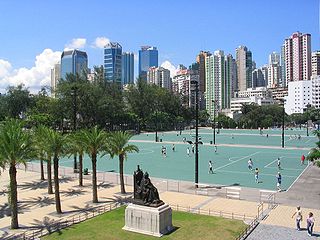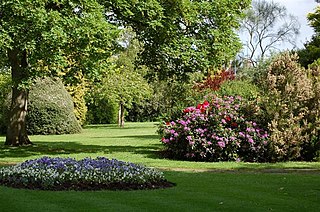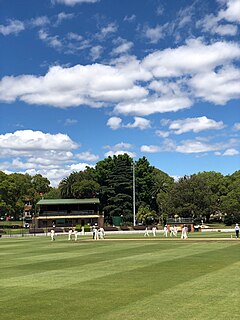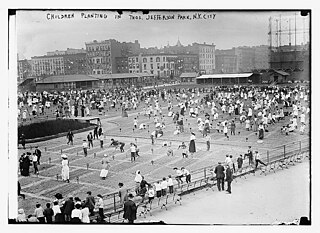
Victoria Park is a public park covering 190,000 square metres in Hong Kong, and is one of Hong Kong's central attractions. The park is named after Queen Victoria of the United Kingdom. It is located in Causeway Bay, on the north of Hong Kong Island, between Causeway Bay and Tin Hau MTR station Exit A2. It is part of Wan Chai District, bordered by Victoria Park Road and then Victoria Harbour to the north and Causeway Road and Hong Kong Central Library to the south. The park underwent a major revamp in the early 2000s, which gave it many of its new and rebuilt features, including basketball courts, tennis stadiums, and swimming pool.

Ponds Forge International Sports Centre is a leisure complex in Sheffield, England, that contains an Olympic-sized swimming pool with seating for 2,600 spectators, family and children's pools, water slides and other sports facilities.

Beacon Park is a public park in the centre of the city of Lichfield, Staffordshire, in the United Kingdom. The park was created in 1859 when the Museum Gardens were laid out adjacent to the newly built Free Museum and Library. The park has since been extended in stages and now forms 69 acres (28 ha) of open parkland in the city centre. The park is in the northwest of the city centre and to the west of the Cathedral Close across the road from the Garden of Remembrance.

Hillsborough Park is a large parkland area in Hillsborough, Sheffield, South Yorkshire, England. It is situated three miles north-westof the city centre. It owned by Sheffield City Council and is one of the 13 designated "City Parks".

Graves Park is a large parkland area in the South of Sheffield, between the districts of Norton, Woodseats and Meadowhead. The park was developed by Alderman J. G. Graves between 1926 and 1936, to protect the thousand year old woodland from building development. Mr Graves donated the 100.362 hectares park to the city.

Yeronga Memorial Park is a heritage-listed park at Ipswich Road, Yeronga, City of Brisbane, Queensland, Australia. The park has an area of 224,600 square metres (2,418,000 sq ft) and is one of the oldest in Brisbane, having been established in 1882, and has been a World War I memorial since 1917. It was added to the Queensland Heritage Register on 2 December 2005.

Millhouses Park is a public urban park located in the Millhouses neighbourhood in south of Sheffield, England. It is a 12.87-hectare (31.8-acre) park stretching approximately 0.75 miles (1.2 km) along the floor of the valley of the River Sheaf, sandwiched between Abbeydale Road South (A621) and the railway tracks of the Midland Main Line.

Longley is a suburb of the City of Sheffield, in South Yorkshire, England. It lies four km north of the city centre and is a residential neighbourhood made up mostly of housing built by Sheffield City Council in the late 1920s. The suburb falls within the Firth Park ward of the City.

Leigh Sports Village is an £83 million multi-use sports, retail and housing development in Leigh, Greater Manchester, England. The centrepiece of the development is a 12,000-capacity stadium which is home to professional rugby league team Leigh Centurions, Manchester United's under-19 and under-23 teams and Manchester United W.F.C. The complex also plays host to amateur rugby league club Leigh East and amateur athletics club Leigh Harriers, who both occupy dedicated facilities on the site. Other facilities on site include the Leigh campus of Wigan and Leigh College, Leigh Sports Centre, which includes a gym, multi-use sports hall and swimming pool, a Holiday Inn Express hotel, a Morrisons supermarket and the Whistling Wren pub.

Goodwin Sports Centre is a sporting facility and gym in the Crookesmoor area of the city of Sheffield, South Yorkshire, England. Its facilities include a 33 m swimming pool, bouldering wall, tennis court, cricket nets, gymnasium, sports hall and several synthetic pitches. It is owned by the University of Sheffield.

Sunnyside Amusement Park was a popular amusement park in Toronto, Ontario, Canada that ran from 1922 to 1955, demolished in 1955 to facilitate the building of the Metro Toronto Gardiner Expressway project. It was located on the Lake Ontario waterfront at the foot of Roncesvalles Avenue, west of downtown Toronto.

Sunnyside Bathing Pavilion is a landmark public pavilion in the Sunnyside lakefront area of Toronto, Ontario, Canada. Built in 1922, its original function was to provide changing facilities for swimming in Lake Ontario, however lake conditions were often too cold and an adjoining public swimming pool was built in 1925. The Pavilion was renovated in 1980 to provide updated changing facilities and a café along the beach and a garden.

Eirias Park is a 50-acre (20 ha) public park in Colwyn Bay, Conwy County Borough, Wales, was once described as "The park by the sea". The park has a sports complex, including the Eirias Stadium and Colwyn Leisure Centre.
Most leisure centres in Cardiff, capital of Wales, are owned by Cardiff Council. Since 2016, the running of eight formerly Council-run leisure centres has been outsourced to Greenwich Leisure Limited, operating under their 'Better' branding. Channel View Leisure Centre continues to be managed by Cardiff Council, whilst the Cardiff International Pool in Cardiff Bay is run separately by another private company.

Woking Park is a large park and leisure complex in Woking, Surrey, operated and maintained by Woking Borough Council. The park is in the Hoe Valley and will be affected by the Hoe Valley Scheme.

Musgrave Park is a public park in Belfast, Northern Ireland.

Firth Park is a public park in the Firth Park area of the City of Sheffield in England. It is located 3.75 km north-northeast of the city centre. The main entrance to the park is on Hucklow Road although there are several entrances on Firth Park Road to the east and one on Vivian Road to the south. Established in 1875, the park gave its name to the Sheffield suburb of Firth Park, a social housing estate constructed around the area of the park in the 1920s and 1930s.

Betsy Head Park is a 10.55-acre (4.27 ha) public park in the Brownsville neighborhood of Brooklyn in New York City. The park occupies two non-contiguous plots diagonally across from each other at the intersection of Dumont Avenue and Thomas S. Boyland Street, covering a collective 10.55 acres (4.27 ha). The modern-day park contains a playground, a swimming complex, and fields for baseball, football, tennis, and basketball. The park's swimming complex, the Betsy Head Play Center, was designed by Ely Jacques Kahn and consists of a bathhouse, a general swimming pool, and an infilled diving pool. The park is operated by the New York City Department of Parks and Recreation, also known as NYC Parks.

Petersham Park is an urban park located in the Inner West of Sydney, New South Wales, Australia. The park is characterised by well established avenues of Brush Box and Camphor Laurel trees.

Thomas Jefferson Park is a 15.52-acre (6.28 ha) public park in the East Harlem neighborhood of Manhattan in New York City. The park is on First Avenue between 111th and 114th Streets. It contains a playground as well as facilities for baseball, basketball, football, handball, running, skating, and soccer. The Thomas Jefferson Play Center within the park consists of a recreation center and a pool. The park and play center, named for former U.S. president Thomas Jefferson, are maintained by the New York City Department of Parks and Recreation.




















